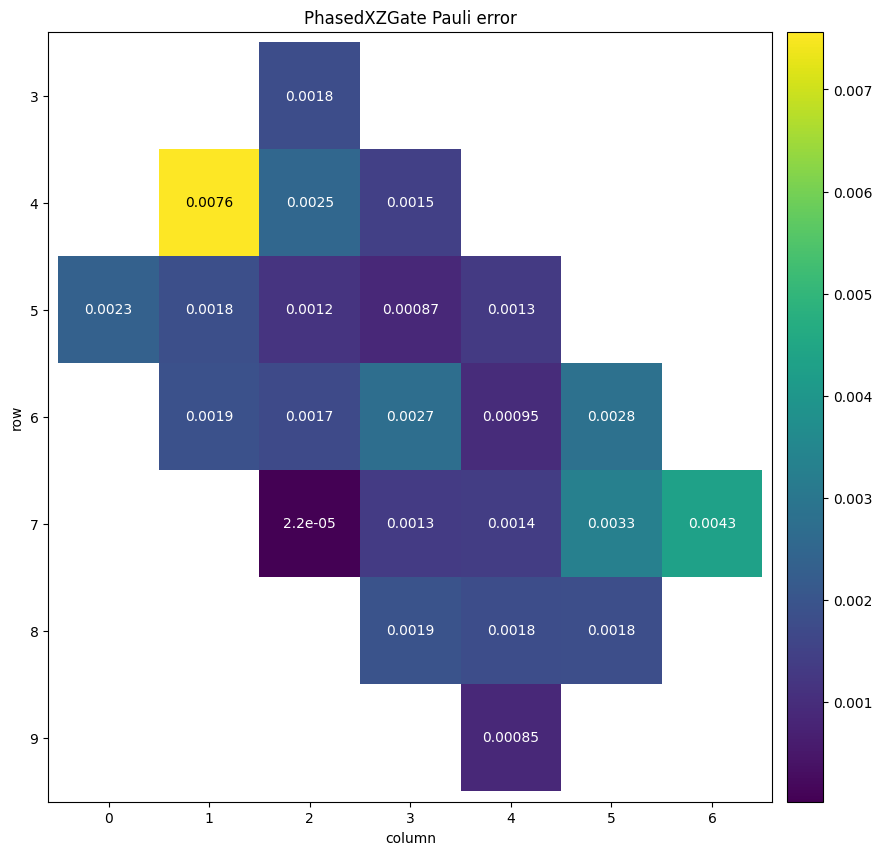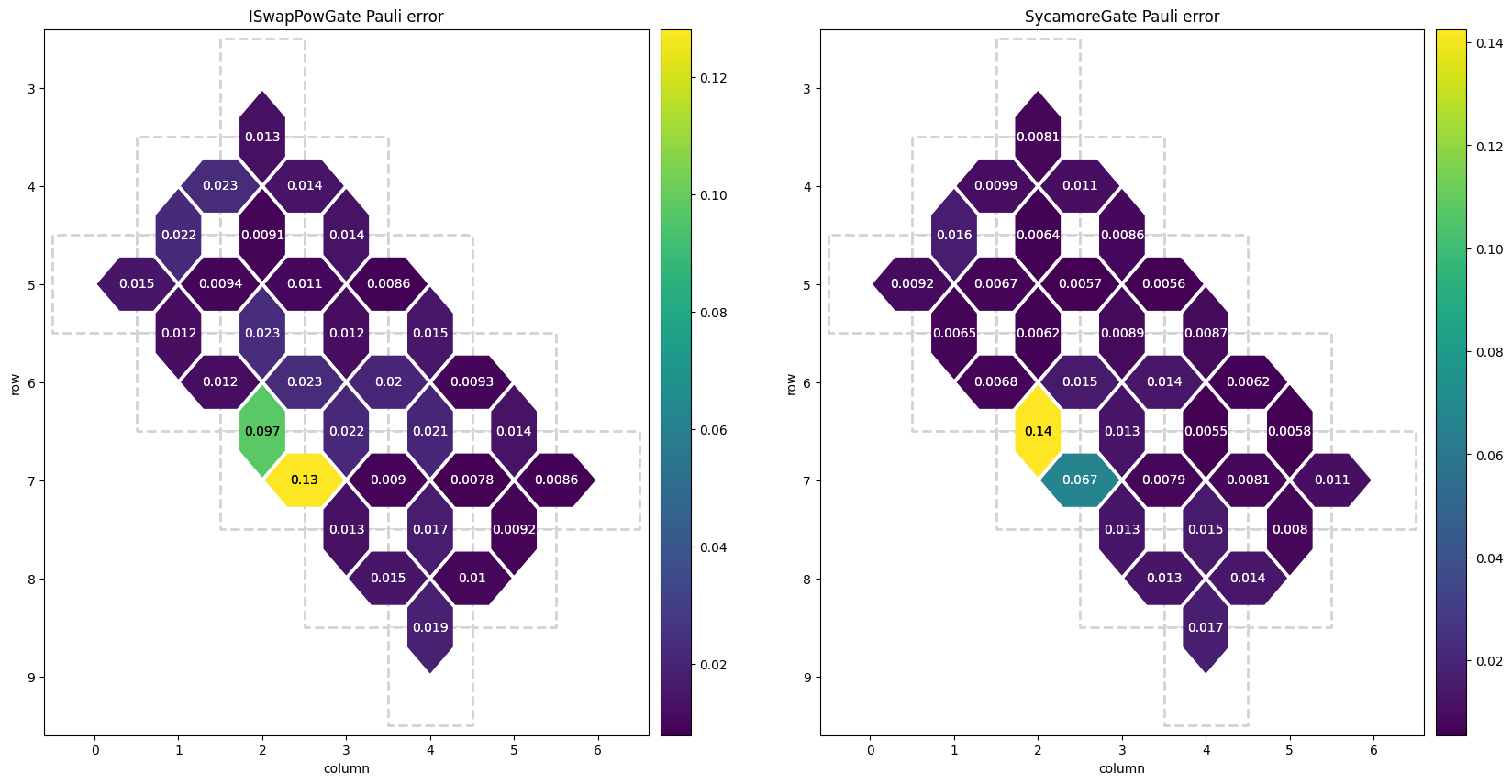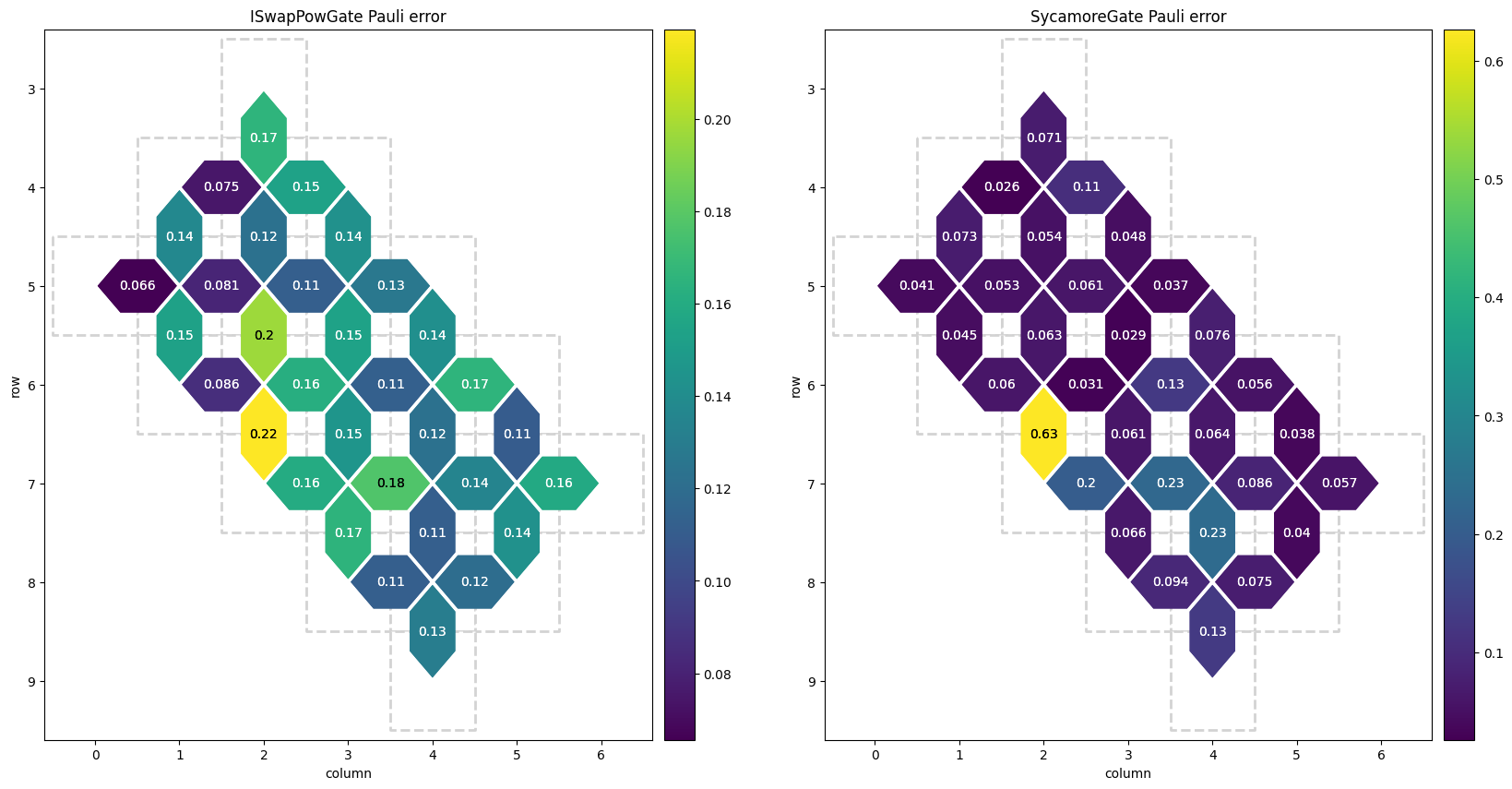 View on QuantumAI View on QuantumAI
|
 Run in Google Colab Run in Google Colab
|
 View source on GitHub View source on GitHub
|
|
When running a circuit on a noisy quantum hardware device, the choice and even ordering of hardware qubits used directly affects how reliably the device measures a correct result. This notebook covers some of the available qubit error information that can be useful for picking good hardware qubits to run your circuit on.
# @title Setup
try:
import cirq
except ImportError:
print("installing cirq...")
!pip install --quiet cirq
print("installed cirq.")
import cirq
import cirq_google
import numpy as np
from matplotlib import pyplot as plt
State of qubit selection in Cirq
Cirq assumes that circuits you intend to run on quantum hardware (virtual or otherwise) are able to be placed on the device, and assumes that you are able to perform placement by hand. The information in this notebook serves to help you identify which qubits are the best to use, but it is up to you to map the qubits in your circuit to the "good" qubits available on the device.
Error characterization data
Cirq provides characterization error data that is intended to represent median performance of actual Google quantum hardware as accurately as possible. The primary use of this data is for creating a cirq.NoiseModel for use in a Quantum Virtual Machine, but it also provides information on what qubits are the best to use for your circuit.
The following code demonstrates how to load that noise data as a cirq_google.GoogleNoiseProperties object, which specifies the available data.
processor_id = "rainbow"
noise_props = cirq_google.engine.load_device_noise_properties(processor_id)
One qubit gate Pauli error data
Pauli error defines decoherence of a single qubit in one of the Pauli channels X, Y, or Z. If the errors are distributed in the uniform distribution over all three axes, the probability of applying an erroneous Pauli gate X, Y, or Z will be the Pauli error divided by three. See page 11 of this Supplementary Information document for more on Pauli error.
Below is the single qubit Pauli error for the cirq.PhasedXZGate supported by the Rainbow processor, pulled from the gate_pauli_errors attribute of the noise properties object. You can inspect the error for the other supported one-qubit gates by replacing the gate variable below. However, as of July 19th, 2022, the error estimation process results in identical Pauli error for all one-qubit gates.
print(f"One qubit error data: gate_pauli_errors")
print(f"Supported Gates: {noise_props.single_qubit_gates()}")
fig, ax = plt.subplots(figsize=(10, 10))
gate = cirq.PhasedXZGate
measures = {
op_id.qubits: pauli_error
for op_id, pauli_error in noise_props.gate_pauli_errors.items()
if op_id.gate_type == gate
}
ax.set_title(f"{gate.__name__} Pauli error")
_ = cirq.Heatmap(measures).plot(ax)
fig.show()
One qubit error data: gate_pauli_errors
Supported Gates: {<class 'cirq.ops.common_gates.ZPowGate'>, <class 'cirq.ops.common_channels.ResetChannel'>, <class 'cirq.ops.phased_x_z_gate.PhasedXZGate'>, <class 'cirq.ops.measurement_gate.MeasurementGate'>}

The provided error data shows identical Pauli error for all gate types, with relatively higher error for qubits (4,1) and (7,6). Qubit (7,2) is noticeably lower error than the others, and could be prioritized to be mapped to a circuit qubit that executes many single-qubit operations. However, this is only one type of error; you should inspect the other error types before committing to use any particular qubits.
Two qubit gate Pauli error data
The two qubit gates also cause Pauli decoherence, which is also stored in the gate_pauli_errors attribute.
two_qubit_gates = noise_props.two_qubit_gates()
print(f"Two qubit error data: gate_pauli_errors")
fig, axes = plt.subplots(1, 2, figsize=(20, 10))
axes = iter(axes)
for gate in two_qubit_gates:
measures = {
op_id.qubits: pauli_error
for op_id, pauli_error in noise_props.gate_pauli_errors.items()
if op_id.gate_type == gate
}
if measures:
ax = next(axes)
ax.set_title(f"{gate.__name__} Pauli error")
_ = cirq.TwoQubitInteractionHeatmap(measures).plot(ax)
fig.show()
Two qubit error data: gate_pauli_errors

This Pauli data informs that the qubit pairs (6,2)-(7,2) and (7,2)-(7,3) should be avoided at all costs, but the other qubits are roughly comparable.
Two qubit gate FSim error
FSim error represents coherent two-qubit error that cannot be represented by Pauli channels (that is, it results from entanglement). Instead, it is represented as an additional cirq.PhasedFSimGate with small parameters that would be applied to a given qubit pair after any two-qubit gate's execution.
The following example takes the norm of a couple of the parameters, as a rough approximate representation of the goodness of qubit pairs relative to one another.
print(f"Two qubit error data: fsim_errors")
two_qubit_gates = noise_props.two_qubit_gates()
fig, axes = plt.subplots(1, 2, figsize=(20, 10))
axes = iter(axes)
for gate in two_qubit_gates:
measures = {
op_id.qubits: fsim_refit_gate
for op_id, fsim_refit_gate in noise_props.fsim_errors.items()
if op_id.gate_type == gate
}
if measures:
ax = next(axes)
# Norm the Fsim refit gate parameters as an approximate of how good a qubit is.
measures = {
qubits: np.linalg.norm([fsim_refit_gate.theta, fsim_refit_gate.phi])
for qubits, fsim_refit_gate in measures.items()
}
ax.set_title(f"{gate.__name__} Pauli error")
_ = cirq.TwoQubitInteractionHeatmap(measures).plot(ax)
fig.show()
Two qubit error data: fsim_errors

This fsim data would influence you to avoid the (6,2)-(7,2) qubit pair, and prefer the top left of the grid for high-priority qubit pairs (those that have two-qubit gates executed on them many times in your circuit). Additionally, the fact that the cirq.SycamoreGate error is so much lower than the cirq.ISwapPowGate error means the device was likely calibrated for the SycamoreGate, and you should transform your circuit with cirq.optimize_for_target_gateset to the cirq_google.transformers.SycamoreTargetGateset gate set, if possible.
This particular type of error can be compensated for somewhat by using Floquet calibration, but this is out of scope for this notebook, and may require adaptation to work with the provided processor error data.
Readout error
Readout error manifests as a measurement of \(|0\rangle\) that should have been \(|1\rangle\), or vice versa. Note that this is different from the Pauli error induced by the cirq.MeasurementGate. It's important to note that, while the magnitude of measurement error is higher in general than that of Pauli error, it should be not automatically be considered to be more impactful. This is due to the fact that Pauli error can affect qubits other than the measured one and that effective readout error compensation strategies exist (that won't be discussed here).
print(f"One qubit error data: readout_errors")
fig, axes = plt.subplots(1, 2, figsize=(20, 10))
for i, ax, title in zip(
range(2), axes.flat, ["True |0> measured as |1>", "True |1> measured as |0>"]
):
measures = {
qubit: readout_error[i] for qubit, readout_error in noise_props.readout_errors.items()
}
ax.set_title(title)
_ = cirq.Heatmap(measures).plot(ax, vmax=0.4, vmin=0)
fig.show()
One qubit error data: readout_errors

This readout data indicates that you definitely want to avoid qubit (7,2). If you're really trying to eke out the best performance possible, you may want to avoid qubits (5,2) and (5,3) as well. Note how the "True \(|1\rangle\) measured as \(|0\rangle\)" error representing common decay is far larger and more impactful than the random excitation of \(|0\rangle\) to \(|1\rangle\) error. This is typical behavior and you can safely prioritize working around common decay error instead of random excitation error in most cases.
Overall qubit picking strategy
Even though the single Pauli qubit data preferred qubit (7,2), the coupled pairs attached to that qubit have abysmal error rates, meaning it should be avoided at all costs. Qubit (4,1) has some interesting properties in that its two-qubit gates are quite good, and so is its readout, but not its single-qubit Pauli error. It may be useful to use this qubit in an entangled system where only the other qubits have single-qubit gates applied to them. All of the other gates are roughly comparable based on these error rates. Ultimately, the choice of which hardware qubits have which circuit operations applied to them is up to your discretion.
Summary
Cirq provides the following error types which serve to represent an actual Google quantum hardware device as accurately as currently possible:
- One- and two-qubit Pauli error for each
cirq.Gatesupported by the device - Two-qubit Fsim error for each supported two-qubit gate that models non-Pauli error.
- Readout error for each qubit that models error in measurements.
While often used to create QVMs, this data is also useful in the process of finding good qubits to use. By avoiding high error qubits whenever possible, you can maximize the reliability of your circuit.
If you're working with an actual device that may experience drift, or a change in behavior over time, you may need to use more advanced noise compensation strategies, which you can read about in the Noise category.
